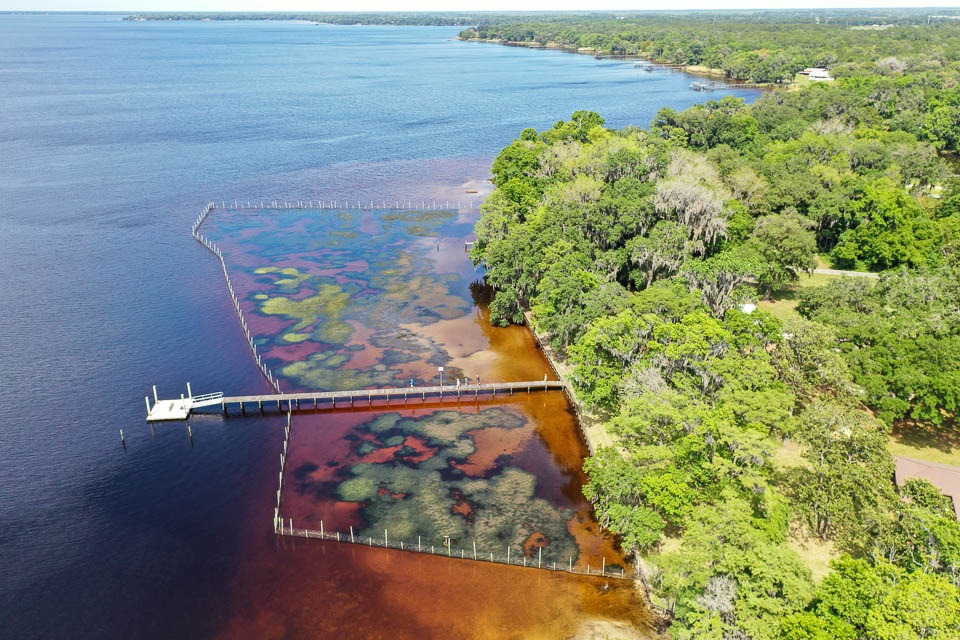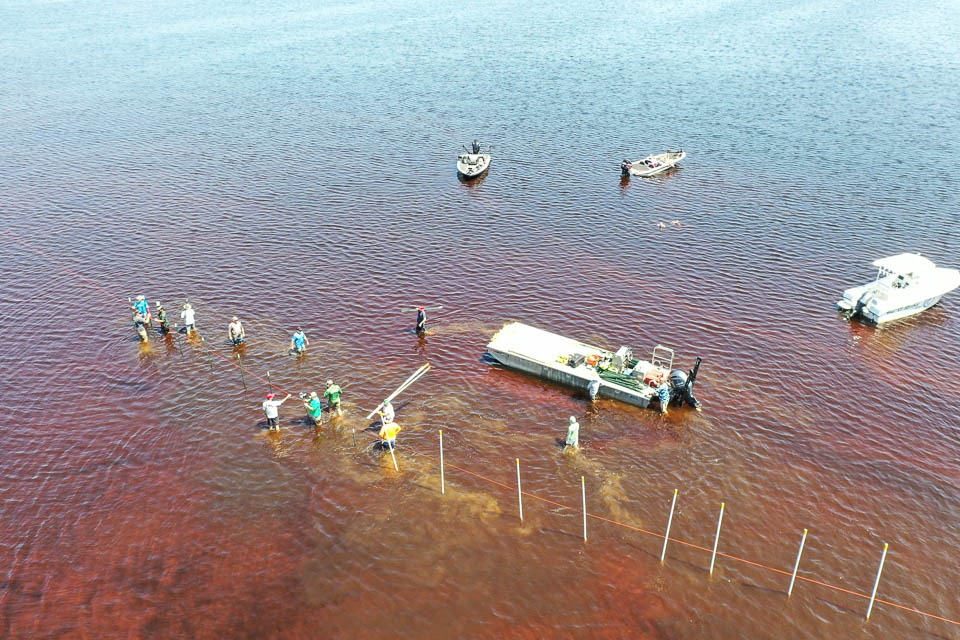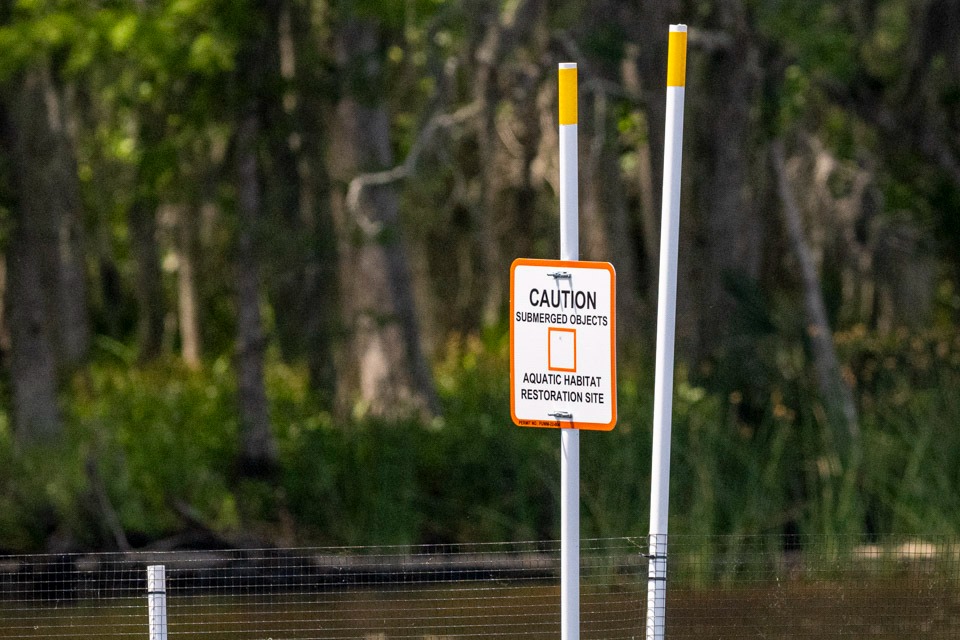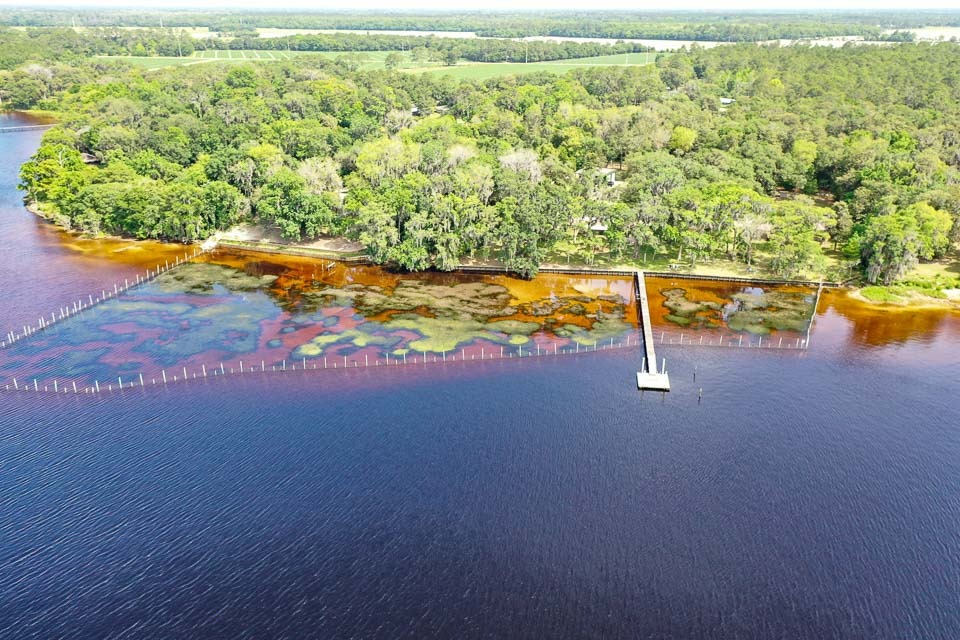
The Florida Fish and Wildlife Conservation Commission has restricted access to key areas of the St. Johns River. Barriers have been built and intrusion is strongly discouraged.
The message is clear: “Do Not Enter!”
But hold on, we don’t want you to get the wrong idea. The FWC’s not trying to limit anglers’ ability to enjoy this renowned bass fishery. No, the agency’s more concerned with a persistent threat that needs no boat, electronics or hooks.
Turtles.
Yeah, that one’s gonna need clarification, so here we go.
Grass in the past
Bottom line, it’s all about habitat. Same as anywhere bass roam, you can’t expect good fishing when the neighborhood declines. That defines the present St. Johns River dilemma.
Thankfully, the FWC is taking action to try and reverse a negative environmental trend that has greatly diminished what was once a stellar bass fishery.
For clarity, the St. Johns still pumps out plenty of quality fish, as this week’s MAXAM Tire Bassmaster Elite event has shown. However, something’s missing and that something has historically played an integral role in the river’s health and productivity.
Eel grass.
Lush fields of tall, slender stalks once packed the major pools of Crescent Lake and Lake George, with scattered coverage throughout the system. FWC Biological Administrator Dan Kolterman describes the plant’s undeniable impact.
“The eel grass and submersed aquatic vegetation (SAV), in general, in the St. Johns River provides many ecological services,” Kolterman said. “It provides foraging and nesting habitat for many fish and wildlife, including largemouth bass.
“The SAV stabilizes sediments and reduces shoreline erosion. It cleans the water and provides better water quality.”

Destruction without recovery
Now, the fact that today’s St. Johns River is largely devoid of eel grass is nothing new. It’s happened before.
However, the cyclical has become the sustained.
As an FWC document explains, eel grass coverage in most natural systems expands and contracts from one year to the next. The unusually active 2005 hurricane season, which produced 28 named storms — the most since 1933 (until 2020 brought 30) — ravaged the St. Johns and eliminated nearly all of the river’s eel grass.
Three years later, the FWC recorded hundreds of acres of returning eel grass that maintained widespread coverage. Sadly, 2017 saw Hurricane Irma plow its way up the state (following Hurricane Matthew’s Atlantic coast skirting a year earlier) and, once again, the St. Johns eel grass was gone.
“Both of those hurricanes had extensive impacts on the system,” Said Kolterman, who oversees the St. Johns habitat work. “They physically uprooted vegetation and threw it up in trees.
“Following each of those storms, we had high, dark water that persisted for months. It blocked the light penetration needed for photosynthesis to occur and those plants that didn’t get ripped up were, essentially, drowned out.”
It’s been nearly seven years and no significant eel grass return.
In natural cycles, when water levels allow sufficient sunlight penetration, eelgrass regrows from seeds and/or rhizomes (horizontal stems) in the substrate. FWC biologists studying the St. Johns noticed eelgrass was germinating, but not maturing.
Stay with us. We’re getting to the turtle thing.
Taking action
Describing a period of harsh reckoning, Kolterman said: “In 2019-2020, we noticed the vegetation was not coming back on its own, so in 2020, we built some small fence enclosures around the (remaining eel grass) to try and jump start the recovery.”
As Kolterman explained, several river residents present a constant threat to SAVs, particularly eel grass. Manatees often come to mind, but invasive non-native tilapia are known to uproot eel grass just to chew off the algae.
Evidence from Virginia even shows freshwater tolerant blue crabs (present in the St. Johns) taking a toll on eel grass, but topping the troublemaker list — yep, those pesky turtles.
The fencing idea made sense, but trial-and-error would improve materials and methods.
“We had some issues with turtles getting inside the small fences and grazing down all the vegetation,” Kolterman said. “So in 2021, we started experimenting with different fence styles (which were tighter). We built more enclosures and we planted those sites as well.”

Observation & analysis
Replacing the original chicken wire design with welded wire fencing that buries into the sediment, the FWC created rigid, impenetrable barriers that have shown great promise for long-term eel grass protection. This also created a vital testing opportunity.
“In 2022, we used the fencing method that worked well and we built two 1-acre enclosures,” Kolterman said. “We cross-fenced those two sites, so we had (two half-acre sections per site) and we planted one half of each site.
“The reason we didn’t plant the other half of each site was because in 2020, we saw a bunch of different SAV species naturally germinate and thrive inside the fences. So we saw the seed bank was intact and those plants were allowed to mature in the absence of grazing pressure.”
Leveraging the fortified enclosures, the FWC was able to monitor natural growth within a protected environment. Kolterman said the results were promising — and enlightening.
“The half we didn’t plant looked just as good as the half we planted,” he said. “We had multiple species on both sides and there was really no difference in coverage. We had plants recruiting naturally in both sides from seed banks.
“We figured out that we don’t need to plant in some areas of Lake George, whereas, in other areas, we have significantly damaged shorelines. Seed banks maybe got damaged or covered (by displaced) sediments. There are areas in Lake George that will require planting, but there are other areas where the seed bank is still viable.”
Moving forward
Last year, the FWC focused solely on fencing and found that a stainless steel option performed best. Armed with a fresh strategy, the agency utilized this knowledge for 2024’s new projects, as well as a requisite replacement plan.
On April 16, FWC staff and volunteers installed fencing near Bayard Conservation area between Palatka and Green Cove Springs. Including this project, the agency has installed nine enclosures with a combined 14,000 feet of fencing since March 2.
“In 2021 and 2022, I had several fishermen reporting a lot of eel grass in the lower river that (showed signs of herbivory),” Kolterman said. “We went down there and found the vegetation had grazing characteristics on it, but it was very dense in coverage.
“So, we worked with the fisherman to enclose some of those areas that had a lot of vegetation that was being grazed down heavily. Ultimately, what we found on Lake George was that if we fence an area that currently has vegetation in it, that vegetation will come on strong. No need to plant it.”
Also, Kolterman said last year’s high water damaged much of Lake George’s existing fence work. Those structures are under contract for replacement with the new and improved stainless steel.
“This is a novel project; we’re writing the book as we go,” Kolterman said. “There’s no storybook to tell us how to do this.”
Despite the steep learning curve and unfavorable weather patterns, Kolterman said he sees plenty of cause for optimism.
“We’ve experienced high water ever since Hurricane Irma; we haven’t any drought,” he said. “Drought’s what brings back the vegetation, because the low water creates higher water clarity and allows sunlight penetration.
“But in the presence of high water, we’ve still been seeing some great things.”

Not a moment too soon
Echoing the concerns of anglers who cherish memories of the St. Johns’ heyday, while lamenting its disheartening decline, B.A.S.S. Conservation Director Gene Gilliland lauded the FWC’s efforts to repaint the river’s portrait.
“The FWC St. Johns River project is among the largest scale revegetation efforts anywhere in the country — and it needs to be,” Gilliland said. “With such a vast area and a large herbivore population, they will need to fence and plant huge plots to reach what I call a ‘critical mass,’ where the vegetation can survive and outgrow the critters trying to eat it.
“It will be a long, tough, and expensive battle but that’s what it will take to restore this fishery to its former glory. We (B.A.S.S.) want to do what we can to help tell the story and advocate for long-term public and legislative support of FWC’s efforts.”
Kolterman said most of the St. Johns River habitat restoration work has been funded through the state budget. The agency also has partnered with the Fish and Wildlife Foundation of Florida, which provided $100,000 (private donations) in 2023 for Lake George fencing.
Last year, the FWC combined this donation with its 2023 budget of $250,000 to install 40,000 feet of fence covering 132 acres.
Kolterman said the FWC has submitted state funding applications for 2025 and 2026, while also pursing outside grant opportunities. Most recently, the Bass Pro Shops/Cabelas Outdoor Fund donated $200,000 for St. Johns River habitat restoration.
“Ultimately, the vegetation coming back is what’s going to bring the fishery back,” Kolterman said. “When and how and how fast, that’s kind of up in the air. There’s a lot of circumstances that could prevent some of that.
“If the grass comes back next year, and we get another tropical storm, that could have some impacts. But ultimately, we expect that once the grass starts coming back, the fishery is going to start rebounding along with it.”
Get involved
Kolterman said the FWC welcomes volunteers for the St. Johns River and other habitat restoration programs. Visit https://myfwc.com/get-involved/volunteer.
Elsewhere, outdoors industry marketing and media pro Joe Balog, a lifetime angler who frequently visited the Sunshine State before relocating there in 2015, recently founded Mighty River Recovery. A non-profit environmental advocacy group dedicated to improving the St. Johns’ fish and wildlife habitat, while working to organize and unify outdoor enthusiasts.
For full image gallery, click here.





